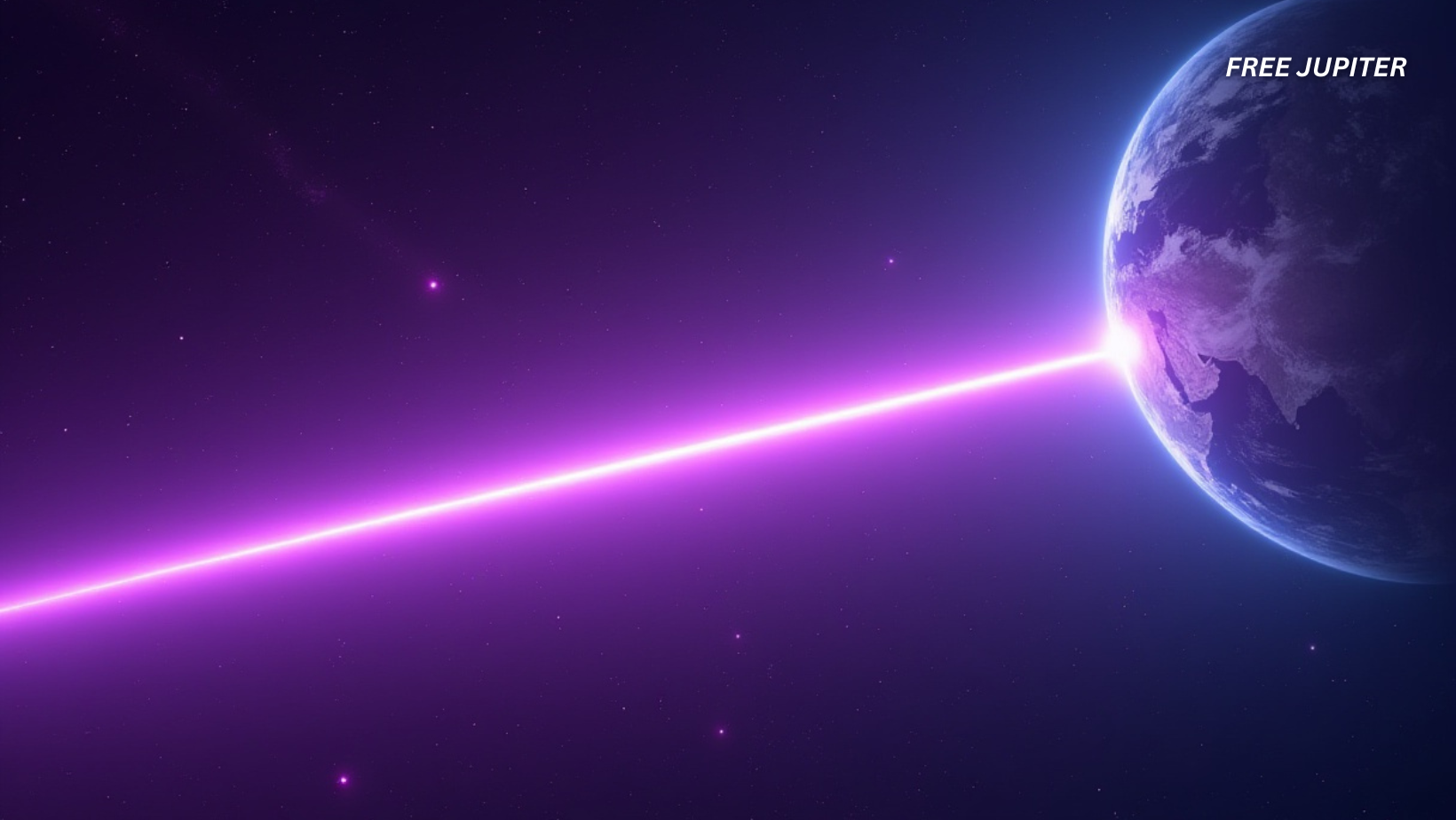When you picture space travel, you might imagine rockets, astronauts, or robotic landers exploring alien worlds. But one of the less glamorous—yet absolutely vital—parts of venturing into the cosmos is communication. After all, what good is a mission if the data never makes it home?
That’s why NASA’s Psyche spacecraft just pulled off something extraordinary. It sent its final laser message back to Earth from 218 million miles away—a distance so immense it makes our everyday ideas of “far” feel almost comical. This wasn’t just a casual ping, either. It was the capstone to a cutting-edge experiment that could shape the way humanity talks across the stars.
A Cosmic Record-Breaker
In December 2024, Psyche managed to fire off a laser signal across 494 million kilometers (307 million miles) of space. For comparison, that’s more than twice the typical distance between Earth and Mars, and about 1,285 times the distance to the Moon.
Think of it like this: if radio waves are our usual walkie-talkies for space, Psyche just tested out the universe’s version of fiber-optic internet—one that relies on beams of light instead of broad radio signals.
This achievement was part of NASA’s Deep Space Optical Communications (DSOC) technology test. The experiment ran alongside Psyche’s main assignment: traveling to the asteroid belt to study a mysterious, metal-rich asteroid named (fittingly) Psyche.
Since its launch in 2023, the spacecraft successfully sent 65 laser downlinks back to Earth, the last of which was received from 350 million kilometers (218 million miles) away. With the laser test now complete, Psyche will continue on its path to the asteroid belt, using good old-fashioned radio waves to send data.
Read more: A Blue Jay–Green Jay Hybrid Has Been Confirmed For The First Time Ever in Texas Backyard
Why Use Lasers at All?
If radio waves already work, why bother with lasers? The answer lies in speed and capacity.
NASA’s Deep Space Network (DSN)—the global system of massive radio antennas that talk to spacecraft—has been a faithful workhorse for decades. It guided Apollo astronauts, kept Voyager in touch with home, and continues to track probes throughout the Solar System. But it’s also running into a problem: demand.
There are now so many spacecraft sending back data—from weather satellites to Mars rovers—that the system is stretched thin. Radio signals also have a natural bottleneck: they just can’t carry as much information as light-based communication.
Lasers, by contrast, have much higher bandwidth. That means they can send far more data in the same amount of time. Imagine trying to download a movie over dial-up versus high-speed fiber internet—that’s the difference NASA is aiming for.
Sean Duffy, NASA’s acting administrator, explained it simply: “Laser communications could one day let us stream high-definition video directly from Mars.” In other words, the dream of astronauts FaceTiming Earth from the Red Planet isn’t so far-fetched anymore.
What Psyche Actually Sent
During the DSOC test, Psyche transmitted an astonishing 13.6 terabytes of data to Earth’s ground stations. Among the highlights was a high-definition video beamed from more than 30 million kilometers away at 267 megabits per second.
That’s not just a technical milestone—it’s the fastest deep-space data transfer ever achieved. To put it in perspective, 267 megabits per second is comparable to many household broadband connections. Except this connection didn’t come from across town—it came from across interplanetary space.
Why the “Final Ping” Was Closer
You might wonder: if Psyche set a record at 307 million miles, why was its last signal sent from only 218 million miles away?
The explanation has nothing to do with the spacecraft’s performance. Instead, it’s all about orbital mechanics. Psyche is circling the Sun on a path that sometimes brings it closer to Earth and sometimes farther away. So, depending on the timing, its distance to Earth varies dramatically.
Read more: Scientists Successfully Treat Huntington’s Disease for the Very First Time
The Difficulties of Using Lasers in Space
While lasers sound like the perfect solution, they come with challenges.
Radio waves are forgiving. They spread widely, so even if the spacecraft isn’t perfectly aligned, Earth’s antennas can still catch the signal. Lasers, on the other hand, are narrow, needle-thin beams. They need precise aiming to hit their receivers. Think of shining a laser pointer at a coin on the other side of a football field—except the football field is hundreds of millions of miles wide, and both you and the coin are moving.
There’s also the issue of distance. Light weakens as it travels, so the farther the beam goes, the fewer photons (tiny packets of light) make it to Earth. When Psyche was about 225 million kilometers away in April 2024, its downlink rate had already slowed to just 25 megabits per second.
Earth itself adds another complication. Our planet’s atmosphere, with its clouds, dust, and weather, can scatter or block incoming light. That means ground-based receivers sometimes struggle to catch the signals. In the future, NASA may need to build relay stations in space to help capture and store laser messages more reliably.
A Test of Limits—and Success Beyond Expectation
Despite these hurdles, Psyche’s test proved far more successful than NASA originally hoped.
Clayton Turner, associate administrator of NASA’s Space Technology Mission Directorate, summed it up: “Over two years, this technology surpassed our expectations, demonstrating data rates comparable to household broadband internet and sending engineering and test data to Earth from record-breaking distances.”
In other words, not only did DSOC work—it worked so well that it changed expectations for what future missions might achieve.
Why This Matters for the Future
Laser communication isn’t just a fancy upgrade; it’s a necessary step if humans want to expand deeper into space.
As robotic probes, telescopes, and human missions multiply, the amount of data skyrockets. Imagine trying to share streaming video, scientific observations, spacecraft telemetry, and crew communications all through the same old radio channels—it would be like trying to run the modern internet on 1990s dial-up.
With lasers, NASA and other space agencies could manage the flood of information more efficiently. That means faster science, clearer communication, and even the possibility of real-time or near-real-time video from other planets.
It’s also crucial for future Mars missions. Whether robotic or crewed, explorers on the Red Planet will need a way to send back massive amounts of information quickly—everything from weather updates to medical data. Psyche’s successful test shows that such communication is no longer theoretical.
Raed more: ‘Black Diamond’ Apples Exist — A Rare Variety Only Found in China And Tibet
Final Thoughts
Psyche’s final laser “hello” may sound like a small step, but it represents something much larger: humanity inching closer to a future where exploring the Solar System—and maybe one day beyond—is not only possible but sustainable.
For now, Psyche will keep sailing deeper into space, headed for its asteroid namesake. And back on Earth, scientists will keep dreaming of the day when Mars isn’t just a distant red dot in the sky, but a place where humans live, work, and beam home laser signals faster than we can even imagine.
Because in space, communication isn’t just about talking—it’s about discovery. And Psyche just proved that the future of talking to the stars may shine brighter than ever.
Featured image: Freepik.
Friendly Note: FreeJupiter.com shares general information for curious minds. Please fact-check all claims and double-check health info with a qualified professional. 🌱










